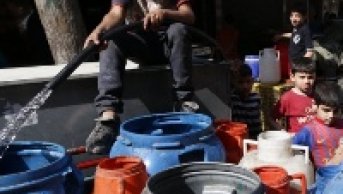The Water Problem in the Middle East

While the Middle East covers 10 percent of the world’s surface area, 5 percent of the world population is found here.
On the other hand, 2 percent of the world’s precipitation falls on Middle Eastern countries, which account for 3 percent of the annual average water potential worldwide. The main water resources in this region, which has some 25 rivers, are precipitation, rivers and groundwater. Two-thirds of current renewable water resources in the Middle East originate outside of the region; these resources are called transboundary waters. With an arid climate prevailing, 80 percent of the region is desert. Semi-arid zones are found in small areas of the region. The arid region’s precipitation rate is less than 5 millimeters annually. The annual average evapotranspiration rate is 2,000 millimeters.
The average annual water supply per capita in the world has been calculated at 7,000 cubic meters. To get this figure, researchers assumed an equal distribution of water among the world population. However, global water resources are not, in reality, equally distributed, and in regions where semi-arid climatic zones prevail, water is scarce. In the Middle East, which is the most important of these regions, the average annual water supply per capita is currently some 1,200 cubic meters. The majority of the countries in the Middle East are predicted to suffer water shortages after 2015.
In a region where water is rare, the water problem has been worsened by deteriorating water quality in recent years. The use of water in salt extraction and for industrial, domestic and agricultural purposes leads to pollution. In addition to quantitative and qualitative aspects of the water problem in the Middle East, there is also an equity problem. The region has water problems at the local, national and international levels. Water resources affect relations between states, cities, tribes and ethnic groups, and the use of water resources is affected by the aforementioned relations.
Water use in the Middle East and North Africa has a direct impact on the economy. In the Middle East, 60-90 percent of the region’s water is used for agriculture, 1-10 percent for industry, 3-10 percent for human consumption, and 3-20 percent for hygiene.
The main causes of the water problem in the Middle East are commonly thought to be the following: the semi-arid and arid climate, rapid population growth, low precipitation rates and falling precipitation in recent years: drought, intense evaporation, unequal distribution of water resources regarding population density, mismanagement of water resources, insufficient water storage units, insufficient technical infrastructure, conventional irrigation methods and excessive water loss. Sudden changes in sociopolitical structures threaten food insecurity (poverty, hunger and malnutrition).
Moreover, conflicts are frequent and often long-lasting in the Middle East. It is often said that religion and ethnicity are major factors leading to these conflicts. Cooperative institutionalization is weak in the Middle East, so the balance of power directly affects the water supply. In fact, water resource management -a technical problem- becomes a political issue. One of the reasons for this is the scarcity of water, a security issue that can threaten the survival of states.
Although progress in water management has recently been made, the problem cannot yet be solved in economic and environmental terms. Intense use of regional aquifers and pollution are serious public health, water quality and environmental concerns. Agricultural water use has a serious negative impact on other sectors. Some countries in the region experiencing water shortages use fossil aquifers, desalinate water and strive to find alternative solutions with unconventional methods by reusing waste water. Also, the Middle East uses more than 60 percent of the world’s desalination capacity.
The prerequisites for finding a solution to the Middle East’s water problem are political will from interested countries, cooperation, treaties and legal arrangements. However, instabilities in the region prevent government bodies from becoming more professional and also hinder cooperation between and the sustainability of these agencies. Meanwhile, ideas for technical solutions to the region’s water problem are being put forward. In agriculture, where water resources are used most intensely, modern irrigation methods and the rehabilitation of damaged infrastructure could make water use more efficient. Some other solutions that have been suggested: wastewater treatment to reuse water, virtual water, storing rainwater, the direct use of hard water or treating hard water, building underground dams to minimize evaporation losses, aquifer alimentation, the desalination of seawater, inter-basin water transfers and cloud seeding.
Furthermore, some are suggesting developing technologies to increase energy capacity to meet the requirements of desalination, to ensure the safe and low-cost use of water of marginal quality, and to improve water management. Beyond technological developments and cooperation, political will, institutional structures and government support are also important for the productive use of water.







